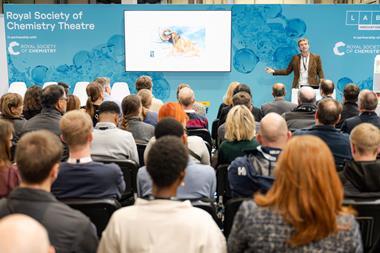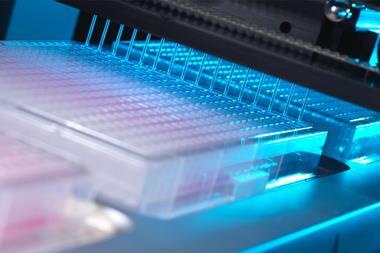Despite rapid advances in the complexity and power of research methodologies, most biological laboratory research is still conducted the same way it has always been: manually and ‘one factor at a time’. Reaching valuable scientific insights faster requires a new approach.
Working with leading biotechnology and pharmaceutical companies across the world, the interdisciplinary team of computer scientists, biologists, mathematicians and chemists at Synthace is pioneering new ways of working digitally in biology. Synthace empowers researchers with digital tools and flexible automation to address the problem of biological complexity.
Join our webinar on 1 September 2020 at 12pm (BST) when Synthace will show how to transform new product development processes.
Central to their approach is design of experiments (DOE). With strong roots in bioprocess optimisation, Synthace offers scientists a codeless, flexible, user-friendly environment for designing, optimising and executing sophisticated DOE with no programming knowledge required.
DOE is about getting the most information out of every experiment
Michael Sadowski, head of bioinformatics, Synthace
DOE and biosciences
DOE enables a holistic and statistical approach to studying biological systems that simultaneously considers multiple factors and their interactions. ‘When investigating biological systems, it’s easy to list as many potential influences as you want to,’ explains Michael Sadowski, head of bioinformatics at Synthace. ‘But traditional experimental techniques then force you to make an arbitrary choice about nearly all of them to investigate them one at a time. Making potentially important decisions on such an arbitrary basis at an early stage is a horrible thing to have to do. Getting away from that is very powerful.’
DOE can be used to optimise the design of biological assays and processes, enabling scientists to gain reproducible and more robust insights. However, performing sophisticated DOE requires lots of pipetting of varying volumes in complex patterns. Beyond a certain level you need a liquid handling robot but programming a robot to perform liquid handling steps may not always be intuitive to scientists without a programming background.
Recognising this problem and keen to enable scientists to perform sophisticated DOE without the need for prior programming knowledge, Synthace developed its cloud-based platform, Antha. Antha transforms DOE input into instructions for automated liquid handlers and provides structured data sets ready for immediate analysis. The step change in the size and scope of experiments and the volume of data generated with Antha means that scientists also need the best tools for experimental design and data analytics. From the start, Synthace has used JMP software because it offers the complete package of powerful and flexible DOE tools and easy-to-use visual and statistical exploration of scientific data.
They were able to characterise a spectrophotometric enzymatic assay using a space-filling DOE, totalling 3,456 runs for two sets of triplicates of 384 runs…
For the scientists working with these capabilities, it means experiments and lab workflows can be rapidly automated, and data from those workflows can be automatically integrated and linked to their experiments, enabling new insights into complex and dynamic biological systems. ‘DOE is about getting the most information out of every experiment,’ Sadowski says. ‘If you really think about that, it’s obvious why it’s potentially so useful to predominantly empirical disciplines such as the life sciences.’
…the DOE campaign was executed within one working day by a single user
Synthace chose to integrate JMP for DOE and data analysis with their Antha system because it provides the range of DOE capabilities needed to enable the significant efficiency gains indicated and provides scientists with practical insight from the resulting data analysis. JMP is also extensively used by their clients, making it the logical choice for DOE and data analysis. Integrating JMP with Antha enables Synthace’s clients to greatly reduce the time to the correct decision, enabling the opportunity to make significantly lower-cost, more effective drugs.
Delivering results
Synthace’s results are impressive. With one partner, they achieved a greater than 90% time saving in planning, execution and data aggregation. In this case, they were able to characterise a spectrophotometric enzymatic assay using a space-filling DOE, totalling 3,456 runs for two sets of triplicates of 384 runs and the corresponding controls. The DOE campaign was executed within one working day by a single user, providing a wealth of data for future assay optimisations. They reduced time spent on planning the 20,745 liquid handling steps and data aggregation from the microplate reader, by 75% and 94% respectively.
With another customer, Synthace achieved an 83% time saving from combined design, planning and physical execution, and a 32% resource saving. This allowed their customer’s scientists to focus on the analysis of their results and experimental planning, driving the organisation’s research and development forwards, rather than focusing on tedious and error-prone manual execution.
In short, Synthace’s approach enables biologists to work much faster. Scientists can concentrate on the science rather than having to worry about doing things manually or learning to programme automated instruments. With the right tools geared to the way scientists naturally work, tasks that previously took days, weeks or even months can be reduced to minutes and hours.
When I went through my PhD, we were only exposed to a simplistic view of how to do experiments – one factor at a time. It’s incredible how much of the life sciences has gone down this route
Sybil Wong, director of strategic partnerships, Synthace
Transforming biotech research
Biotech firms are striving to make discoveries that deliver life-changing products but, as with any R&D effort, they are likely to have more work than time. Resources may be stretched, and outcomes and timeframes can be unpredictable. DOE can help to deliver insights more quickly than brute force approaches, and demonstrate the reliability, scalability and accountability that organisations need from their research and development teams.
By helping teams make better decisions faster and meet project milestones more predictably, DOE and the automation enabled by Synthace means that biotech and pharmaceutical companies can stay focused on their goals. Robust statistical analysis incorporating DOE can reduce the number of experiments that need to be conducted while delivering results more quickly – essential for demonstrating a return on investment and speeding up time to market.
For Sybil Wong, Synthace’s director of strategic partnerships, the key benefit of Antha lies in ‘making sure that scientists’ time is well spent designing and then analysing experiments rather than in the execution of the experiments.’ Synthace’s approach frees up research scientists to focus on the ‘why’ instead of the ‘how’.
We remove the restrictions human-only experimentation places on the complexity of our experiments
Michael Sadowski
Sadowski talks passionately about the transformative power of this new approach to biological R&D: ‘We’ve already seen some great efficiency savings applying DOE but it’s just the tip of the iceberg – the more we make experimental execution accessible to computational tools the more experimental complexity we can manage. And that makes the scope of what an individual scientist can achieve substantially more powerful.’
The future of biotech
Wong is confident that DOE will transform the biotech sector’s ability to innovate. ‘When I went through my PhD, we were only exposed to a simplistic view of how to do experiments – one factor at a time. It’s incredible how much of the life sciences has gone down this route.’ Many universities are recognising the need for DOE to feature more prominently in postgraduate courses and are starting to place a stronger focus on digital skills. Synthace thinks current proficiency with manual experimental techniques will be superseded by an increased demand for data analytics capabilities, along with a renewed focus on a fundamental understanding of biology.
Most importantly, Synthace’s approach places scientists at the heart of their vision of the future. By augmenting their innate capabilities with the right digital tools and facilitating wider use of DOE, scientists will be far more likely and able to achieve rapid results and find solutions to the world’s biggest challenges. ‘Complex systems need complex experiments,’ Sadowski says. ‘Computer-aided biology is the way we remove the restrictions human-only experimentation places on the complexity of our experiments and thus of the systems we can engineer and understand.’
Join our webinar on 1 September 2020 at 12pm (BST) when Synthace will show how to transform new product development processes.


















No comments yet